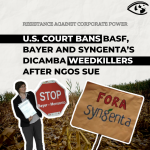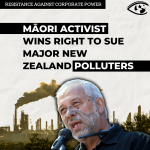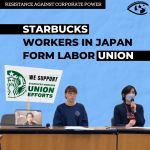The Tobacco Industry Impacts on Tanzania
|
Tanzania, a country twice the size of California, is located in East Africa, just south of Kenya. Last year I was there for 3 months researching the impact of World Bank and IMF economic policies on the country's small farmers who make up the overwhelming majority of the population. While Tanzania produces only .2 percent of world tobacco production, it has been steadily increasing its production. Between 1984 and 1992 the area under tobacco increased by 66%. Recently, Tanzania overtook South Africa to become Africa's third biggest producer of tobacco, after Zimbabwe and Malawi. Currently, there are about 90,000 acres of land under tobacco.
The two farmers I'll talk about, Lowijiso and Elizabeth, live in Kiwere Village which is in the Iringa District in Southwestern Tanzania. Kiwere is set in a valley surrounded by barren, rock-covered hills. I remember on the drive to Kiwere remarking to a colleague how empty the landscape was. Malumbo, who grew up in the area and now works as a development officer for the Lutheran Church, told me that 30 years ago the area was covered with dense forest but that the cutting down of trees to cure the tobacco has left the area devastated.
Lowijiso and Elizabeth, both in their 50s, are neighbors who have been growing tobacco their whole lives. They both grow a bit of maize and peanuts, but tobacco occupies the majority of their land. Both grow about 3 acres of tobacco. Since before independence they have only had a single buyer for their crop. It used to be the British colonial government and after independence, the Tanzania Cigarette Company (TCC), a government-owned corporation. The TCC determine the grades of tobacco (there are about 14) which then determines the price the farmers will get for their crop. The TCC will not buy uncured leaf -- the farmers must assume all of the risk in the curing process.
In 1996 Lowijiso produced about 1,750 lbs of tobacco on 3 acres of land while Elizabeth harvested about 200 pounds more on the same acreage. For each pound they got about 41 cents, which grossed Lowijiso $717. In a country where the per capita income is about $350 a year this sounds like a pretty good deal. But after the costs of all the inputs including fertilizers, pesticides, firewood and the hiring of tractors and labor, is factored in, he should have made about $17. For a year's worth of work. Instead, the local purchasing agent has yet to pay him $500 of the $717 he is owed. Lowijiso said he would file an appeal with the local regulatory commission but didn't expect to win. He told me that since he lost money, he doesn't expect to grow tobacco this year. Elizabeth, who made a small profit since her family provided the labor, will plant again this year.
Tobacco growing, Elizabeth and Lowijiso explained me, involves the following. First, they must clear the land from last year's harvest by digging up and then burning the stalks. They have to then rent a tractor to turn the soil, which costs $25 for 3 acres. Then they use hand hoes to create 55 rows on each acre. To hire labor to help with this costs another $25.
The tobacco seedlings are grown in small nurseries, about 3 miles from their farms, next to a river where there is a constant supply of water. These farmers walk there every day to tend to their seedlings, which are very delicate and require a lot of care. The seedlings need large amounts of pesticides to survive, both before and after transplanting, which cost them about $65 for their 3 acres. Most of these pesticides are toxic; some are carcinogenic. While Tanzania has many good laws on the books governing the sale and use of these pesticides, there is little money for enforcement. Thus tobacco workers and the surrounding communities continue to be exposed to the harmful effects of these chemicals.
After the seedlings are in the ground they require fertilizer which must be applied manually, a task which can take a person 3 days for each acre. Tobacco requires heavy applications of fertilizers, especially nitrogen, since it depletes soil nutrients at a higher rate than many other crops. As a result of the trade liberalization and currency devaluations demanded by the IMF and World Bank, the price of these fertilizers has been rising dramatically. Three years ago a 110 lb. bag of fertilizer costs $6.60 -- today it's $20. Last year, Lowijiso spent $420 dollars on 21 bags of chemical fertilizer. After the seedlings are in the ground, the plots need to be weeded and pruned. To hire someone to weed costs $9 an acre, pruning $3-9 per acre depending on how much there is.
|
After the tobacco is harvested it is hung in rafters in these home-made curing barns. Firewood is then placed in the pipes and lit and then water is poured over the pipes to create steam. If the rains have been bad they have to walk to the river to get water, a trip of 6 miles there and back. The curing process takes about 9 days -- the first 2 days they use steam and after that the barn is sealed and a slow drying process kicks in.
Both Elizabeth and Lowijiso spent about $110 each for the purchase and transportation of the firewood. Since the area around them has been almost completely denuded, firewood sellers must go farther and farther away to collect firewood. Most of this wood is harvested from the wild rather than tree plantations. This has potentially serious implications for local weather and soil conditions. It also competes with the need for firewood for cooking and construction.
Almost all of the tobacco grown in Tanzania is cured this way. Each year, about 99,000 acres of forest, or an area the size of Lassen National Park, is cut down to cure tobacco. Cutting down trees to cure tobacco accounts for about 4% of annual deforestation in the country, a figure which does not include the amount of forest that is being cleared for new tobacco farms, which, as I mentioned, has been increasing rapidly over the last 10 years. While some of the larger growers in the Iringa area use electric curing barns, this creates additional demand for hydro and diesel power which come with their own set of environmental problems.
This loss of forests is never factored into cost-benefit analyses of tobacco growing, but it should be. A World Bank staff person wrote in the mid-eighties that "for every 300 cigarettes made in the developing world, one tree is burned. " I suspect that is still the case.
Growing tobacco is risky. Many small farmers just don't have the capital to buy the fertilizers and insecticides which have shot up in price since the government began implementing the IMF/World Bank economic program. So they borrow. But so much depends upon the rains. If the rains don't come and they have borrowed from the big tobacco growers or the Tanzanian Cigarette Company, they have to find a way to pay back the loan. Each borrower must have 2 guarantors (usually neighbors) who are liable for their debt if they can't pay it back. If they do default, these guarantors then have to sell their possessions or their property.
What's The Link
Unfortunately, the government, as well as the World Bank, IMF and other so-called aid agencies, are doing nothing to help Tanzania reduce its reliance on tobacco cultivation. While the World Bank has adopted a policy of not funding tobacco projects, they have done little in the way of funding alternatives to tobacco production, and their larger macroeconomic conditions which require countries to export their way out of debt means in practice that countries will find whatever way possible, including increasing tobacco production, to pay back these debts. In addition, these economic policies have forced massive cutbacks in government health budgets, crippling public health services which obviously has severe implications for healthcare or even the most basic data gathering, let alone tobacco education work.
It is useless to deny that tobacco is a major employer. However the more relevant question to ask is what these same people might produce if they were growing something else. Since doctors and nurses make their living from taking care of sick people is this a reason to not prevent accidents or do health education? Land mine companies employ people in their factories. Is this a reason not to ban land mines? Also, tobacco control is a gradual process--it's not like people would be thrown out of work immediately. In addition, I think it's important to point out that in most countries it's not the small farmers who benefit from this crop but the middlemen and, obviously, the big tobacco companies.
Yes, there are alternatives to tobacco. Being a relatively labor-intensive crop with a high degree of pesticide and fertilizer use it is hard to argue that there are not more profitable crops. The real question is what the alternatives are and who will help tobacco-dependent farmers make the transition.
As Robert Goodland, a World Bank employee, put it: "Since tobacco production cannot be recommended on human health, social or environmental grounds, investment in tobacco production is ethically questionable. Furthermore, the economic justification for tobacco investments is greatly weakened by expanded cost-benefit analysis that includes such social costs as: health care costs; premature deaths and suffering from smoking-related diseases; impaired worker productivity; damage from smoking related fires; the opportunity costs of reduced food production and consumption of the poor; harm and irritation to passive smokers (especially infants' mental development); soil degradation; environmental and health risks of biocide use; and deforestation and fuelwood depletion, among others."
Let me finish by tying this discussion back to the work we are doing here in the United States.
In November of last year, RJR Nabisco bought a 45% percent share of the Tanzanian Cigarette Company. They have ambitious plans to modernize the Company's plants and use its new base in Tanzania to mount a serious challenge to the dominance of British American Tobacco, which has long held a virtual monopoly in the East and Southern African region. The 30-year old TCC plant in Dar Es Salaam is to be rehabilitated and will soon produce 4 billion cigarettes annually making it one of the biggest manufacturers in the region. Local newspapers have reported that the government has plans to sell more shares to RJR, leaving the company with a controlling interest. This means more demand for tobacco leaf which means more deforestation and pesticide use.
Philip Morris has also been getting into the act in East Africa, dumping cigarettes in neighboring Kenya at below market prices in order to gain new customers. The Marlboro name brand had been introduced in Kenya in the past through its lavish sponsorship of an annual motor rally, but failed to attract many new consumers, perhaps due to its strong taste which is alien to most Kenyan smokers. Learning from its mistakes, the company recently launched Bond Street, a milder blend they hope will be better appreciated by Kenyans.
Having recognized the threat on its territory, BAT relaunched its flagship brand, Embassy, at the end of the last year and revamped its advertising for the brand. In the next year, BAT plans to invest $18 million on the modernisation of its Kenyan plants. The implications for human health and the environment of all this corporate activity should be obvious.
The tobacco industry will tell you that tobacco is a profitable crop for thousands of small farmers in the third world. If my observations in Tanzania are any indication, this is just another lie to justify their deadly industry. Aside from the negative environmental and health aspects, tobacco production is a money loser for most of the people involved. But showing corporate executives profiting from the toil of Tanzanian farmers probably wouldn't be such a great marketing strategy, would it?
- 109 Tobacco
- 194 World Financial Institutions





